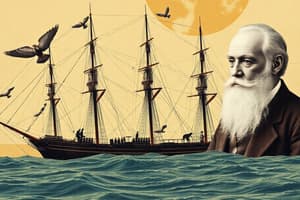Podcast
Questions and Answers
In what year was the Origin of Species published?
In what year was the Origin of Species published?
1859
What subjects were studied in Natural History?
What subjects were studied in Natural History?
Rocks, fossils, weather, geography, and all the biological sciences
What were Darwin's main passions of study?
What were Darwin's main passions of study?
Geology and biology
What was Darwin an enthusiastic collector of?
What was Darwin an enthusiastic collector of?
What was the name of the naval ship Darwin was invited to join on its long voyage around the world?
What was the name of the naval ship Darwin was invited to join on its long voyage around the world?
What were Darwin's roles on the Beagle?
What were Darwin's roles on the Beagle?
How long did the voyage on the Beagle last?
How long did the voyage on the Beagle last?
Where did the Beagle spend most of its time?
Where did the Beagle spend most of its time?
What did Darwin gather at every opportunity?
What did Darwin gather at every opportunity?
What environments did Darwin explore?
What environments did Darwin explore?
What species did Darwin become an expert on?
What species did Darwin become an expert on?
What does 'mutable' mean?
What does 'mutable' mean?
What is the 'transmutation of species'?
What is the 'transmutation of species'?
What was the traditional view of species in Darwin's day?
What was the traditional view of species in Darwin's day?
What point did Darwin make that he called 'descent with modification'?
What point did Darwin make that he called 'descent with modification'?
What is another term for 'descent with modification'?
What is another term for 'descent with modification'?
What was at the heart of Darwin's theories?
What was at the heart of Darwin's theories?
What did Darwin call the process through which changes in species occur?
What did Darwin call the process through which changes in species occur?
What is the concept of deep time?
What is the concept of deep time?
What were two items that puzzled over and encouraged the idea that the earth had a deep past?
What were two items that puzzled over and encouraged the idea that the earth had a deep past?
What are three reasons Darwin waited so long to publish his theory?
What are three reasons Darwin waited so long to publish his theory?
What are the steps of the scientific method?
What are the steps of the scientific method?
Flashcards are hidden until you start studying
Study Notes
Publication and Background
- "On the Origin of Species" was published in 1859, marking a significant moment in scientific literature.
- Key subjects of Natural History include rocks, fossils, weather, geography, and biological sciences.
Darwin's Interests and Experience
- Darwin had a strong interest in geology and biology.
- As a dedicated collector, he focused particularly on beetles.
- He took part in a crucial voyage on the HMS Beagle, serving as a naturalist and companion to the captain.
- The Beagle's voyage lasted 5 years, allowing extensive exploration.
Voyage and Findings
- The Beagle spent considerable time along the coasts of South America, Tahiti, New Zealand, South Africa, and the Galapagos Islands.
- During the voyage, Darwin collected various specimens, including insects, plants, and animals.
- He explored diverse environments such as rain forests, deserts, grasslands, and coral reefs.
Research and Discoveries
- Darwin became an expert on barnacles, relatives of crabs and lobsters found attached to surfaces like rocks and ships.
- He introduced the concept of "mutable," defining it as the capacity for permanent change in species.
- His idea of "transmutation of species" explained long-term changes in species over time.
Theories on Species and Evolution
- The traditional belief of Darwin's time held that species were divinely created and unchanged.
- Darwin proposed "descent with modification," signifying that living organisms evolve and change over generations, leading to new species.
- This concept of descent with modification is synonymous with evolution.
Mechanisms of Change
- At the core of Darwin's theories was understanding how changes in species occur.
- He identified "natural selection" as the process driving evolutionary changes.
Geological Insights
- The notion of "deep time" refers to the extensive geological history of Earth unfolding over vast ages.
- Puzzling observations, such as seashells on mountain tops and extinct fossils, supported the idea of an ancient Earth with a deep past.
Publishing Considerations
- Darwin delayed publishing his theories due to apprehension about criticism and potential backlash.
- He aimed for a robust body of evidence to support his claims, continuously testing various theories.
- His efforts were hampered by health issues, including bouts of sickness and periods of exhaustion and grief.
Scientific Method
- The scientific method consists of making observations, posing questions, formulating hypotheses, predicting outcomes, testing predictions, and refining hypotheses based on results.
Studying That Suits You
Use AI to generate personalized quizzes and flashcards to suit your learning preferences.




